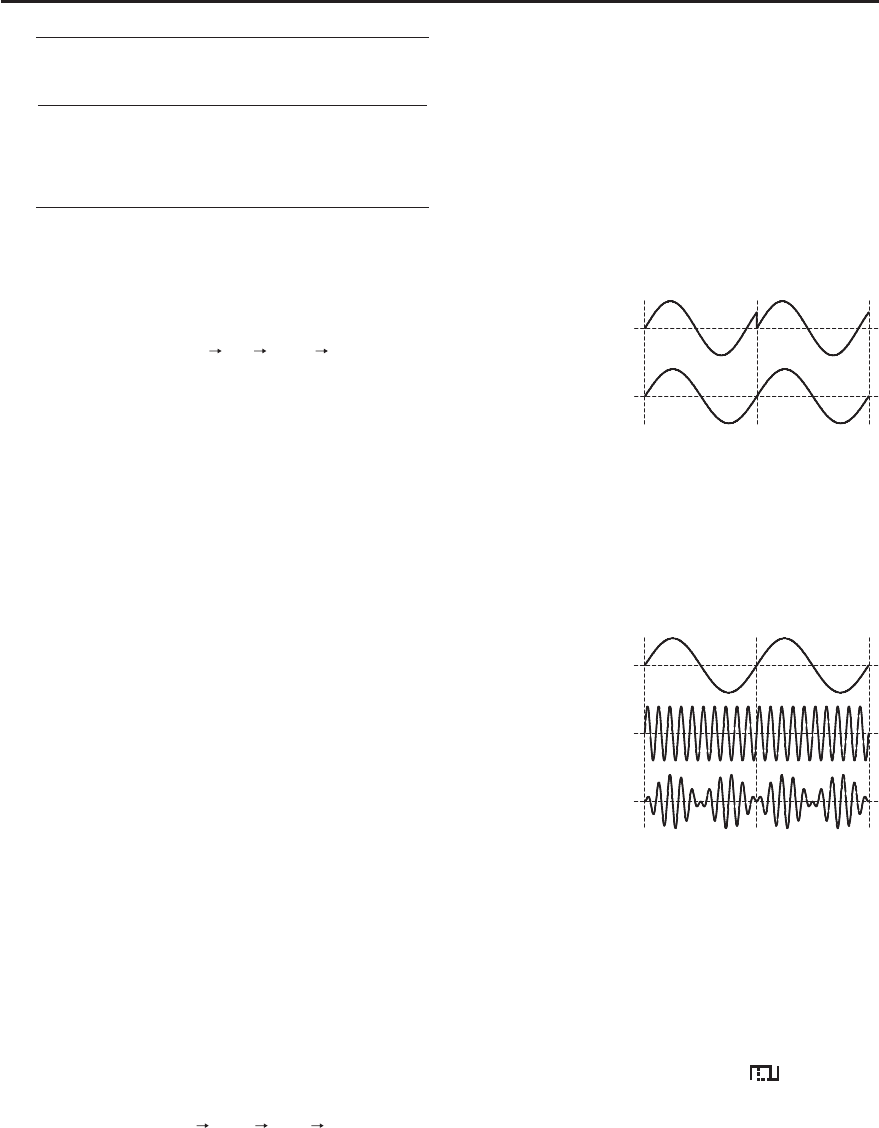
31
NOISE
Noise
This waveform contains all frequencies.
It is suitable for percussion instrument
sounds or sound e ects.
SUPER SAW
Super Saw
This produces a tone similar to seven
sawtooth waves heard simultaneously.
Pitch-shifted sounds are added to the
center sound. It is suitable for strings
sounds, and for creating thick sounds.
[ VARIATION] button
You can select variations of waveforms.
There are three variations for each waveform, and the
[WAVE] button will change color according to the selected
variation, as follows: unlit
red green unlit ...
[ PITCH] knob
This knob sets the pitch.
• Turning the knob toward the right will raise the pitch in
semitone steps. Turning the knob all the way to the right
will make the pitch two octaves higher than when the
knob is in the center position.
• Turning the knob toward the left will lower the pitch in
semitone steps. Turning the knob all the way to the left will
make the pitch two octaves lower than when the knob is
in the center position.
[ DETUNE] knob
This knob adjusts the pitch in ner steps than the [PITCH]
knob.
By layering tones and slightly shifting their pitches away
from each other, you can create a sense of modulation and
depth (a “detune” e ect).
• Turning the knob toward the right will raise the pitch.
Turning the knob all the way to the right will make the
pitch 50 cents higher than when the knob is in the center
position.
• Turning the knob toward the left will lower the pitch.
Turning the knob all the way to the left will make the
pitch 50 cents lower than when the knob is in the center
position.
[ MOD] button
This button combines the sound of tone 1 and tone 2 in
order to create more complex sounds.
Press the button to select the way in which these tones will
be combined; the corresponding indicator will light.
Pressing the button cycles you through the available
choices, as follows: OFF
SYNC RING OFF ...
OFF
Tone 1 and tone 2 will sound independently.
SYNC (Oscillator sync)
Tone 1 will forcibly be reset to the beginning of its
cycle at the frequency of tone 2, creating a complex
waveform.
The OSC 1 waveform will change as shown in the
illustration, and OSC 2 will be output with its original
waveform.
This is e ective when the tone 1 pitch is higher than
the tone 2 pitch.
OSC 1 waveform
(output waveform)
OSC 2 waveform
* If you’ve selected SYNC (oscillator sync), the MONO
setting will be forcibly chosen.
RING (Ring modulator)
By multiplying OSC 1 and OSC 2, this creates a complex,
metallic-sounding waveform like that of a bell.
The OSC 1 waveform will change as shown in the
illustration, and OSC 2 will be output with its original
waveform.
OSC 1 waveform
OSC 2 waveform
OSC 1 output
waveform
* PW and PWM cannot be used for tones 1 and 2 if you’ve
turned on SYNC (Oscillator Sync) or RING (Ring Modula-
tor).
Also, if the OSC section’s asymmetric rectangular wave
is selected, variations for the OSC become invalid, and
the resulting tonal quality will be somewhat di erent
compared to what it would be with the original wave
selection.
[ PWM] slider
If the [WAVE] button (p. 30) has selected (asymmetrical
square wave), you can use this slider to specify the amount
of LFO modulation applied to PW (pulse width).


















